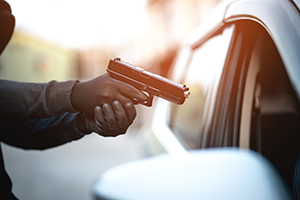Connecticut General Statutes § 53a-136a – Robbery Involving an Occupied Motor Vehicle (Carjacking)

Under § 53a-136a, a person commits Robbery Involving an Occupied Motor Vehicle — commonly referred to as carjacking — when, in the course of committing a robbery, they intentionally take a motor vehicle that is occupied by another person.
This statute was added to strengthen penalties for robberies where the target is a vehicle being driven or occupied at the time of the offense.
Classification and Penalties- Carjacking is treated as an enhanced form of robbery.
- The statute requires that, in addition to the penalty for the underlying robbery (whether 1st, 2nd, or 3rd degree), the defendant must serve a mandatory minimum of 3 years in prison.
- This 3-year sentence must run consecutively — meaning it is added on top of the base sentence for the robbery.
- Example: If convicted of Robbery in the First Degree (5-year mandatory minimum) and carjacking, the minimum sentence becomes 8 years.
Fines and probation: The standard penalties for the underlying robbery class (B, C, or D felony) apply, plus the consecutive enhancement.
Example Scenarios Example 1: Armed CarjackingA man approaches a woman at a stoplight, points a gun at her, and forces her out of the driver’s seat. He drives away in the car. This is Robbery in the First Degree plus carjacking, triggering the 3-year consecutive enhancement.
Example 2: Passenger PresentTwo teenagers push a delivery driver out of his van while his coworker is still in the passenger seat. Even though they didn’t threaten the passenger directly, the fact that the vehicle was occupied makes it carjacking.
Example 3: Implied WeaponA suspect pretends to have a gun by keeping a hand in his pocket and demanding a driver hand over his vehicle. The vehicle is occupied, and the representation of a weapon elevates the robbery charge to 2nd degree, plus the consecutive 3-year sentence under § 53a-136a.
Related Offenses- § 53a-134 – Robbery in the First Degree (Class B felony, 5-year minimum)
- § 53a-135 – Robbery in the Second Degree (Class C felony)
- § 53a-136 – Robbery in the Third Degree (Class D felony)
- § 53a-122 – Larceny in the First Degree (can apply if a vehicle is stolen without direct confrontation)
- § 53a-123 – Larceny in the Second Degree (covers some motor vehicle thefts not involving force or threat)
- Identity challenges – Eyewitness identifications during fast-moving events are prone to error.
- Lack of “occupied vehicle” – If the vehicle was empty at the time, the statute doesn’t apply (though other larceny/robbery charges may).
- Weapon representation disputes – Arguing that no deadly weapon was used or represented.
- Intent issues – Prosecutors must prove intent to take the vehicle from someone in possession or control.
- Suppression motions – Challenging evidence obtained through unconstitutional searches or lineups.
- Negotiation – In some cases, reduction to standard robbery without the consecutive carjacking enhancement may be possible.
It’s robbery involving the taking of a motor vehicle that is occupied by another person at the time.
Is There a Mandatory Minimum Sentence?Yes. There is a mandatory 3-year minimum sentence that runs consecutively to the underlying robbery penalty.
Does the Vehicle Have to Be Moving?No. The statute applies if the vehicle is occupied, whether parked, stopped at a light, or in motion.
What if no One Is Inside the Car?If the car is empty, it’s not carjacking. It may still be charged as larceny or another theft-related crime.
Do I Need to Use a Weapon for It to Count?No. The underlying robbery can be based on force, threat, or representation of a weapon. The key factor is that the vehicle was occupied.
Can Juveniles Be Charged Under This Statute?Yes. Juveniles can be charged, and depending on the facts, cases may be transferred to adult court because of the seriousness of the offense.
How Much Time Could I Face in Total?It depends on the degree of robbery charged. For example:
- 1st Degree Robbery (Class B felony) + carjacking = 8-year minimum (5 + 3).
- 2nd Degree Robbery (Class C felony) + carjacking = up to 13 years, with 3 years mandatory.
No. The 3-year mandatory minimum must be served in prison.
Are Plea Bargains Possible?Yes. In some cases, defense attorneys negotiate for reductions to lower robbery degrees or removal of the carjacking enhancement.
How Is Carjacking Different From Regular Auto Theft?Carjacking involves force, threat, or intimidation against someone occupying the vehicle. Auto theft without direct confrontation is usually charged as larceny.
Take the Next Step<A charge of Robbery Involving an Occupied Motor Vehicle (C.G.S. § 53a-136a) is one of Connecticut’s most severe robbery offenses. The mandatory consecutive 3-year sentence makes it especially high-stakes.
📞 Call Allan F. Friedman, Criminal Lawyer, at (203) 357-5555 or contact me through my contact page for a confidential consultation.
 Allan F. Friedman Criminal Lawyer Home
Allan F. Friedman Criminal Lawyer Home















